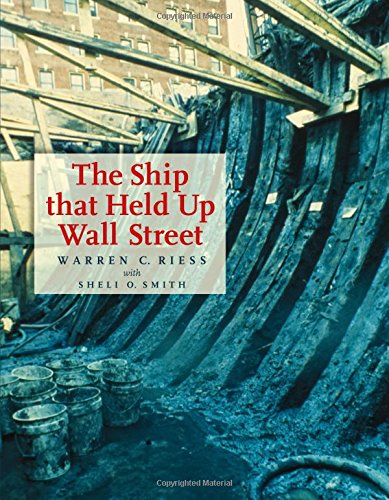The Ship that Held Up Wall Street
Warren C. Riess with Sheli O. Smith
 In January 1982 a backhoe digging a trench at a New York City construction site uncovered the remains of a buried ship—an old one. The trench, one of four, was part of an archeological survey prior to clearing the site for the foundations of a thirty-story office building in Manhattan’s financial district.
In January 1982 a backhoe digging a trench at a New York City construction site uncovered the remains of a buried ship—an old one. The trench, one of four, was part of an archeological survey prior to clearing the site for the foundations of a thirty-story office building in Manhattan’s financial district.
It was soon apparent the ship likely dated from the early eighteenth century. It offered insights on a little-understood period of naval architecture. Construction could be delayed for only a short time. Any study or recovery of the ship in situ had to be completed by March 1.
The Ship that Held Up Wall Street, by Warren C. Riess with Sheli O. Smith, tells what happened next. It reveals the story of a month-long sprint to unearth the ship and the decades-long marathon to unlock the secrets of the find.
The book opens describing the 28-day site dig. Riess relates an urban adventure worthy of an Indiana Jones movie. The excavation took place in February in pre-Giuliani New York City. The archeologists not only had to fight time and February weather, they had to contend with picket lines and gang violence. (Local community activists protested the lack of minority workers at the dig site until they learned the diggers were low-paid archeologists, not high-paid construction workers. A street gang attempted to fire-bomb the ship for reasons still unknown.)
This is followed by a section describing preservation of artifacts and explains what was chosen for preservation and why. It provides a clear, understandable introduction to the science behind stabilizing fragile timber and artifacts.
Riess next unravels the identity of the ship uncovered by construction. The chapter reads like a first-rate mystery novel, as Reiss pieces clues together. Evidence as diverse as the design of the ship, the timber used in construction, and even the species of shipworm which attacked the hull provided critical data. Combined with archival research, it allowed a tentative identification of the ship.
For those most interested in sailing era naval architecture, this is likely the most fascinating chapter. The ship is revealed as a transitional design, a cross between the Dutch fluyte (or flyboat) and British merchant frigate. It was significant find.
After developing the probable career of the ship, Riess explains how and why this ship ended up buried one-tenth of a mile from Manhattan’s present coast. To do this he examines the history of early eighteenth-century New York City. He takes readers into the commercial life of the city, and introduces them to the individuals who developed the lot in the 1740s and 1750s.
The Ship that Held Up Wall Street is a delightful book on several levels. In addition to adventure, mystery, and history, Riess introduces touches of comedy and tragedy describing missteps, near-catastrophe, and dropped opportunities occurring in every effort with tight deadlines and many participants.
The only real disappointment—for model-makers—is a lack of technical detail about the ship’s design and construction. Riess promises that in a second book about the ship, one he is currently preparing. The Ship that Held Up Wall Street will hold model-makers until then.
- College Station: Texas A&M University Press, 2014
- 8-3/4” x 11-1/4”, hardcover, 112 pages
- Illustrations, diagrams, sketch maps, notes, glossary, index. $29.00
- ISBN: 9781623491888
Reviewed by Mark Lardas, League City, Texas
